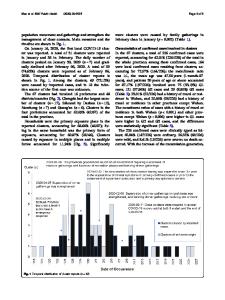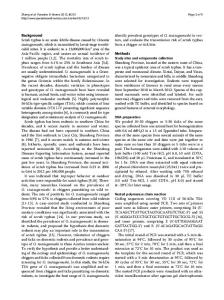Molecular epidemiology of SARS-CoV-2 clusters caused by asymptomatic cases in Anhui Province, China
- PDF / 1,696,995 Bytes
- 13 Pages / 595.276 x 790.866 pts Page_size
- 75 Downloads / 403 Views
RESEARCH ARTICLE
Open Access
Molecular epidemiology of SARS-CoV-2 clusters caused by asymptomatic cases in Anhui Province, China Yuan Yuan1,2†, Jun He1,2†, Lei Gong1†, Weiwei Li1,2, Liangliang Jiang3, Jiang Liu4, Qingqing Chen1,2, Junling Yu1,2, Sai Hou1, Yonglin Shi1,2, Siqi Lu1, Zhuhui Zhang1,2, Yinglu Ge1,2, Nan Sa1,2, Lan He1, Jiabing Wu1, Yong Sun1,2*† and Zhirong Liu1*†
Abstract Background: COVID-19 is a newly emerging disease caused by a novel coronavirus (SARS-CoV-2), which spread globally in early 2020. Asymptomatic carriers of the virus contribute to the propagation of this disease, and the existence of asymptomatic infection has caused widespread fear and concern in the control of this pandemic. Methods: In this study, we investigated the origin and transmission route of SARS-CoV-2 in Anhui’s two clusters, analyzed the role and infectiousness of asymptomatic patients in disease transmission, and characterized the complete spike gene sequences in the Anhui strains. Results: We conducted an epidemiological investigation of two clusters caused by asymptomatic infections sequenced the spike gene of viruses isolated from 12 patients. All cases of the two clusters we investigated had clear contact histories, both from Wuhan, Hubei province. The viruses isolated from two outbreaks in Anhui were found to show a genetically close link to the virus from Wuhan. In addition, new single nucleotide variations were discovered in the spike gene. Conclusions: Both clusters may have resulted from close contact and droplet-spreading and asymptomatic infections were identified as the initial cause. We also analyzed the infectiousness of asymptomatic cases and the challenges to the current epidemic to provided information for the development of control strategies. Keywords: Coronavirus, SARS-CoV-2, Cluster, Asymptomatic case, Spike gene
Background The emergence of new human viral diseases affecting the respiratory tract continues to threaten global public health. Subsequent virological testing revealed a novel CoV in these patients [1]. This new human coronavirus (CoV) strain (SARS-CoV-2) was named by the International Committee on Taxonomy of Viruses (ICTV), * Correspondence: [email protected]; [email protected] † Yuan Yuan, Jun He, and Lei Gong contributed equally to this work. † Yong Sun and Zhirong Liu are senior author contributed equally. 1 Anhui Provincial Center for Disease Control and Prevention, 12560, Fanhua Avenue, Hefei, China Full list of author information is available at the end of the article
and pneumonia resulting from infection with this coronavirus was named “COVID-19” [2]. Coronaviruses, which are widely found in humans and other mammals as well as avian species, cause asymptomatic infections or respiratory tract disorders. The SARS-CoV-2 virus is a new genus Coronavirus of the family Coronaviridae, which contains four other genera, Alphacoronavirus, Betacoronavirus, Gammacoronavirus, and Deltacoronavirus, based on phylogenetics and serology [3]. Among the Coronaviridae that cause human illness, NL
Data Loading...











